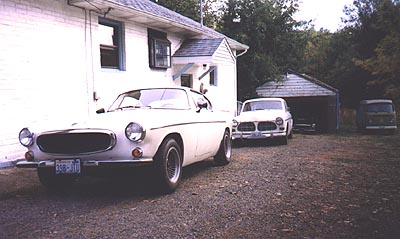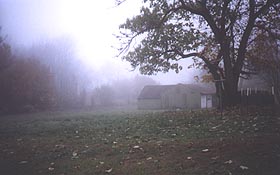 |
 |
|
Phil Singher editor@vclassics.com
This meant that all those little car maintenance items relating to rain and cold -- which it had been immensely easy to defer during the dry 90-degree heat of summer -- assumed a certain relevance. Here, it's not like in places where they salt the roads; not a time to revive the winter beater; not a time to service the "good" car to prepare it for winter storage; but nonetheless a time to remember that Weather Happens. I'm expert at deferring non-essentual maintenance. In the fifteen years I've been driving our 122S, the wiper on the passenger's side has always been a little floppy. It wiped the windshield just fine, so I never got ambitious enough to take things apart and figure out why -- I just put the arm on its post so the wiper wouldn't flop over the windshield trim and got used to leaning over the hood to push it back down after parking. This is the same "What looks good, is good" principle that helped me survive years of downsizing at work. Heck, there are Concours winners that have subsisted on that philosophy for years and they get their pictures into all the club magazines -- who am I to dispute it? During some Volvo dismantling project or other, though, Shayne Green had shown me the usual cause of wiper flop: the inner shaft of each wiper gearbox slides through a square hole in its actuating arm, which some guy in Gothenburg named "Thor" apparently then smashes tight with a hammer. Eventually, the hole starts to round out, and there's the slop. The obvious solution is to spot-weld the arm and shaft together. Hmmm, would take maybe an hour to fix and make a good Tech Tip to boot -- I had to try it. Some days later, with the suspect parts of the right-side wiper gearbox on the bench, I found that ours didn't have that particular problem. The shaft and arm were perfectly fitted. Instead, there's a gear sector that presses onto splines in the shaft, and the splines had partly backed out of the gear. I promptly slipped the gear sector completely off so I could clean off what was left of 30-plus-year-old grease, then promptly spent the next half-hour wondering what angle it had been at before I slipped it off so I'd only have to put it back together once. After I did figure it out and performed some vise-and-hammer work, it was all snugged tighter than a weightlifter's wristwatch and back on the car in no time flat. The wiper operated perfectly -- considering how little I'd worried about it all the years it had flopped, I was pleased all out of proportion to finally have it work completely right. Which it did for about 100 wipes the next rainy day. Then it just quit entirely and wouldn't even twitch under its own power. Well, it was only the passenger's wiper. I left it that way for the moment. Maybe I even liked this better than having it floppy -- saved me the trouble of pushing it back down across a wet hood. If you'd ever worked for my old employer, you'd be good at rationalizing, too. Next: the hole in the roof of our VW bus. It's a camper with a fiberglass pop-top, and, while trying to close up too quickly in a sudden downpour (this was at the ipd Garage Sale in May -- where does the time go?), I'd pulled one end of the inner handle right through the fiberglass. Nothing that couldn't be fixed in twenty minutes with just a few big washers and some sealing goop, once I got around to it -- which was now. The first five minutes went smoothly. The other fifteen -- and then several more hours -- were spent alternately searching in the weeds for the bolt I'd dropped or for its replacement in assorted big bags o'bolts in the Chamber of Horrors. This was not only a metric bolt, but a special "for use only on VW Westfalia fiberglass top handles" bolt that resisted being found a suitable match for as vehemently as the most ancient confirmed bachelor in the entire Imperial British East India Officers Corps. Then I discovered it lying innocently on one of the front seat pedestals. Darned thing hadn't bounced out the door, after all, no matter what the corner of my eye thought it had seen. Well, I was glad to see it, even after all the trouble it had caused. Project accomplished. Our 1800S needed a little winter prep as well. If you've ever sat in one of these in the cold and/or wet with the blower motor not working, you know that it only takes thirty seconds before all the glass in the car looks like it was made out of melted shower doors. Over 40 mph, air blows through the heater box in fine style, but if you see a traffic signal down the road turn yellow, starting to wipe right then is your only chance of staying on top of the fog-up curve. Our blower motor hadn't worked since we'd owned the car. This car I'm not lazy about, but there'd been so much else (and worse) to fix on it that I hadn't managed to look into this particular flaw. Last winter, when we'd had to drive the 1800 because the 122 was only good for turning expensive transmission innards into metal guacamole, our paper towel bill had increased alarmingly. But not this year. I unhooked the wires from the blower connections under the hood. I got my meter, thought better of doing the first check with the wires loose, stuck them back on, turned on the ignition and pulled the control knob out. Blower fired right up and has worked great ever since. This sort of thing makes up for a few dropped bolts and wipers that won't even flop anymore. I was about breaking even, overall. Finally, weeks later, I found I couldn't leave the 122 with a dead wiper. Turned out to be the same old problem, only more so: the shaft had backed out of the gear sector so far that the splines were completely out of the gear. It's only the press fit of the gear that holds the shaft in the box to begin with. I took it all apart again (this time noting the orientation of gear sector and actuating arm), gave it a thorough degreasing and soldered the gear to the shaft using a propane torch. It's run quite a few days now with no trace of flop. So far, so good.

|
 I woke up one morning and saw nothing but a blur outside the bedroom windows. That's what always happens, but this time, the blur persisted even after I fumbled my eyeglasses off the nightstand and stuck them on my face. It was the date of the Autumnal Equinox, and the blur was thick fog. Fall had arrived precisely on schedule.
I woke up one morning and saw nothing but a blur outside the bedroom windows. That's what always happens, but this time, the blur persisted even after I fumbled my eyeglasses off the nightstand and stuck them on my face. It was the date of the Autumnal Equinox, and the blur was thick fog. Fall had arrived precisely on schedule.